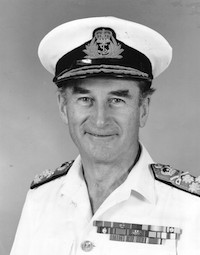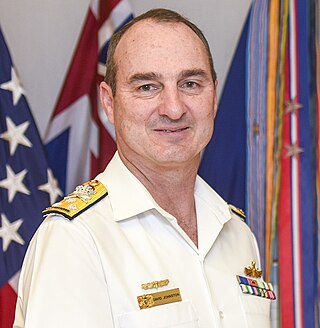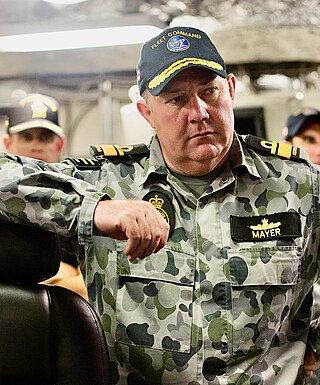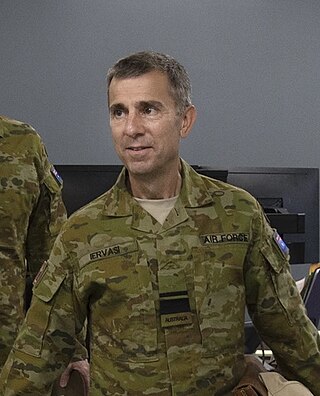Related Research Articles

Vice Admiral Russell Edward Shalders, is a retired admiral of the Royal Australian Navy (RAN). He served as Vice Chief of the Australian Defence Force from 2002 to 2005, and as Chief of Navy from 2005 to 2008.

Admiral Sir Anthony Monckton Synnot, was a senior officer in the Royal Australian Navy, who served as Chief of the Defence Force Staff from 1979 to 1982.
Rear Admiral James Vincent Purcell Goldrick, was an Australian naval historian, analyst of contemporary naval and maritime affairs, and a senior officer of the Royal Australian Navy (RAN). Following his retirement from the RAN, Goldrick was a fellow at the Sea Power Centre – Australia and an adjunct professor in the School of Humanities and Social Sciences in the University of New South Wales at the Australian Defence Force Academy. He was also a member of the Naval Studies Group at the Australian Centre for the Study of Armed Conflict and Society, an adjunct professor in the Strategic and Defence Studies Centre of the Australian National University and a professorial fellow of the Australian National Centre for Ocean Resources and Security at the University of Wollongong. He was a visiting fellow at All Souls College, University of Oxford in the first half of 2015, and a non-resident Fellow of the Lowy Institute from 2013 to 2018.

Vice Admiral Russell Harry Crane, is a retired senior officer of the Royal Australian Navy (RAN), who served as the Chief of Navy from July 2008 until his retirement in June 2011.
Vice Admiral Matthew John Tripovich, is a retired senior officer of the Royal Australian Navy. He served as Chief Capability Development Group from 2007 until his retirement in October 2010.

Rear Admiral Nigel Stephen Coates, was a senior officer in the Royal Australian Navy.
Admiral Sir Victor Alfred Trumper Smith, was a senior officer in the Royal Australian Navy. Smith's career culminated with his appointment as chairman, Chiefs of Staff Committee—forerunner of the role of Australia's Chief of the Defence Force—from 1970 to 1975, following an earlier term as Chief of Naval Staff from 1968 to 1970.

Lieutenant General John Graham Caligari, is a retired senior officer of the Australian Army. He served as Chief Capability Development Group from October 2014 until his retirement in August 2015.

Rear Admiral Stephen Richard Gilmore, is a retired senior officer of the Royal Australian Navy. He served as Commander Australian Fleet from October 2009 until December 2011, and as the Head Australian Defence Staff (Washington) and Australian Defence Attaché at the Embassy of Australia, Washington, D.C. from January 2014 until his retirement in 2017.
Vice Admiral Raymond James Griggs, is an Australian senior public servant and a senior officer in the Royal Australian Navy Reserve. He served as Chief of Navy from June 2011 to June 2014, before being appointed Vice Chief of the Defence Force until his transfer to the reserve in July 2018.
Vice Admiral Peter David Jones, is a retired senior officer in the Royal Australian Navy (RAN), who served as the Chief Capability Development Group (CCDG) from 2011 until his retirement in October 2014. He was succeeded as CCDG by Lieutenant General John Caligari.

Vice Admiral Michael Joseph Noonan, is a retired senior officer of the Royal Australian Navy, who served as Chief of Navy from 6 July 2018 to 6 July 2022. He previously served as Commander Border Protection Command from 2013 to 2015 and Deputy Chief of Navy from 2016 to 2018.

Admiral David Lance Johnston, is a senior officer in the Royal Australian Navy. He served as Deputy Commander Joint Task Force 633 on Operation Slipper in 2010, Commander Border Protection Command from 2011 to 2013 and, following promotion to vice admiral, was posted as Chief of Joint Operations from 2014 until 2018. Johnston was appointed Vice Chief of the Defence Force in July 2018. He was promoted to admiral and appointed Chief of the Defence Force on 10 July 2024.

Vice Admiral Stuart Campbell Mayer, is a retired senior officer of the Royal Australian Navy. He joined the navy via the Royal Australian Naval College at HMAS Creswell in 1984 and qualified as a Principal Warfare Officer in 1994. He commanded HMAS Canberra (2002–04), HMAS Anzac (2007–09) and the International Stabilisation Force (2009–10), and deployed on operations to the Persian Gulf, East Timor, and the Arabian Sea during the Iraq War. He served as Commander Australian Fleet from 2014 to 2018, Head Force Design within the Vice Chief of Defence Force Group from 2018 to 2019, and Deputy Commander United Nations Command, based in South Korea, from 2019 to 2021. He retired from the navy in 2022 and was appointed a partner in Ernst & Young's consulting division.

Vice Admiral Ian Warren Knox, was a senior officer of the Royal Australian Navy (RAN). In a 42-year career, Knox commanded HMA Ships Torrens, Hobart and Melbourne, briefly served as Deputy Chief of Naval Staff, and was Flag Officer Commanding HM Australian Fleet from 1985 to 1987. His career culminated with his appointment as Vice Chief of the Defence Force in January 1987; a position he held until his retirement in September 1989.

Gary William Wight, is an officer in the Royal Australian Navy (RAN). He joined the RAN as a submariner in 1987 and rose through the ranks to become the 8th Warrant Officer of the Navy in 2016. He relinquished the post in 2019 and was subsequently commissioned as an officer.

Lieutenant General John James Frewen, is a retired senior officer of the Australian Army. He joined the army via the Royal Military College, Duntroon and was commissioned into the Royal Australian Infantry Corps in 1986. He has commanded the 2nd Battalion, Royal Australian Regiment (2003–04), Combined Task Force 635 (2003), the 1st Brigade (2012–14), Military Strategic Commitments Division (2014–16) and Joint Task Force 633 (2017–18), and deployed on operations to Rwanda, the Solomon Islands and Afghanistan. He was appointed Principal Deputy Director-General of the Australian Signals Directorate in March 2018, and Coordinator General of the National COVID Vaccine Taskforce in June 2021. He was Chief of Joint Capabilities from September 2021 to July 2024.

Vice Admiral Jonathan Dallas Mead, is a senior officer in the Royal Australian Navy. He joined the navy via the Royal Australian Naval College at HMAS Creswell in 1984, and spent his early career with the Clearance Diving Branch before training as a Principal Warfare Officer. He captained HMAS Parramatta on operations in the Persian Gulf from 2006 to 2007 during the Iraq War and commanded Combined Task Force 150, overseeing maritime counter-terrorism operations around the Arabian Peninsula and Horn of Africa, from 2011 to 2012. He served as Head of Navy Capability from 2015 to 2017, Commander Australian Fleet from 2018 to 2020, Chief of Joint Capabilities from 2020 to 2021, and was appointed Chief of the Nuclear-Powered Submarine Task Force in September 2021.

Vice Admiral Mark David Hammond, is a senior officer in the Royal Australian Navy (RAN), serving as the Chief of Navy since July 2022. He joined the RAN as an electronics technician in 1986 and, after being accepted for officer training, graduated from the Australian Defence Force Academy in 1990. Much of Hammond's career has been spent in the Submarine Service. He has served on operations in the Indo-Pacific, commanded the Collins-class submarineHMAS Farncomb, was Deputy Chief of Navy from 2018 to 2020, and served as Commander Australian Fleet from November 2020 to June 2022. He succeeded Vice Admiral Michael Noonan as Chief of Navy on 6 July 2022.

Air Vice-Marshal Vincent Joseph Iervasi, is a retired senior officer of the Royal Australian Air Force (RAAF). He joined the RAAF in 1985 and gained his pilot's wings in 1989. He deployed to Bosnia and Herzegovina on Operation Deny Flight in 1995, Qatar in support of Operation Slipper in 2014, and to Al Minhad Air Base in support of Operations Okra and Highroad in 2019. He commanded No. 3 Squadron RAAF (2005–08), No. 81 Wing RAAF (2011–12), the 609th Combined Air Operations Centre (2014) and the Air Warfare Centre (2017–18). He was Commander Joint Task Force 633 from January to June 2019 and served as Air Commander Australia from 2019 to 2022.
References
- ↑ Conspicuous Service Cross, It's an Honour
- ↑ Member of the Order of Australia, It's an Honour
- ↑ "Officer (AO) In the Military Division of the Order of Australia" (PDF). 2014 Australia Day Honours. Australian Honours and Awards Secretariat. Retrieved 27 January 2014.
- ↑ "Change of Australian military command in the Middle East" (Press release). Department of Defence. 12 December 2014. Archived from the original on 5 February 2015. Retrieved 5 February 2015.
- ↑ "Australian command handover in the Middle East". Navy News Daily. 28 January 2016. Retrieved 22 June 2016.
- ↑ "Distinguished Service Cross" (PDF). Office of the Governor-General of Australia . Retrieved 26 January 2017.